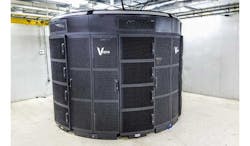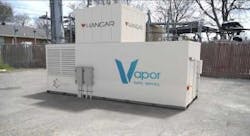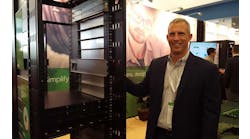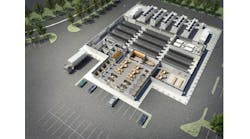Vapor IO Forms Alliance to Move Faster on Edge Deployments
Edge computing isn’t a single technology, but a number of hardware and software technologies that will work together to support new services and faster data transfer. It’s not always easy for customers and users to see how it will all come together.
That’s why edge specialist Vapor IO has organized the Kinetic Edge Alliance, a group of hardware, software and networking companies that will collaborate on integrated edge solutions.
The Alliance “provides the vehicle for delivering nationwide edge computing, removing the guesswork from edge deployment and operations that exists today,” said Cole Crawford, the founder and CEO of Vapor IO. “The alliance will accelerate the rollout of edge computing, delivering a platform for wireless operators and application providers to deliver new edge-enabled products and services to customers.”
Vapor IO is creating a distributed network of edge colocation sites, housed in micro modular data centers that can be deployed at key points on the network, including telecom towers and antenna sites. The Kinetic Edge is Vapor IO’s network design, which uses both wired and wireless connections to create a reliable, low-latency network of colocation sites.
The company has deployed its first two edge units in Chicago, and says it will deploy to an additional five markets with its alliance partners in 2019. The Kinetic Edge Alliance (KEA) plans to eventually deploy infrastructure in the top 30 American markets, supporting edge computing services that can reach 50 percent of the U.S. population.
Beyond Chicago, the KEA’s 2019 plans feature deployments in Pittsburgh, Atlanta, Dallas, Los Angeles and Seattle. The rollout plans suggest that early edge demand will focus on boosting infrastructure density in cities.
“This is an ecosystem opportunity,” Crawford said. “Delivering edge computing at scale, across the entire United States, requires a great deal of collaboration. We know what the building blocks are. Our approach has been to forge partnerships and make this a more collaborative opportunity for everyone.”
Two Categories of Partners
The Kinetic Edge Alliance features two types of partners. Deployment Partners have committed to jointly rolling out equipment and services in Kinetic Edge markets, ensuring a uniform infrastructure platform that makes it easy to build edge applications and deploy them to multiple markets. These partners include Packet, Federated Wireless, StackPath, Linode and MobiledgeX.
Technical Partners support Kinetic Edge partners and end users as they deploy new edge infrastructure services. KEA technical partners include Alef Mobitech, Detecon International, Hitachi Vantara, New Continuum Data Centers, Pluribus Networks, and Seagate Technology.
“By enabling our tech partners, we get to tell a far more holistic story for partners with reference architectures,” said Crawford. “This is the power of this alliance.”
One example is StackPath, a company founded by Lance Crosby, the entrepreneur who built SoftLayer into a cloud powerhouse before selling it to IBM. StackPath helps clients deploy edge solutions using containers, virtual machines and serverless scripting.
“The edge today is analogous to the early days of cloud, and education on the technology and proximity is key to mass adoption,” said Crosby, the CEO of StackPath. “Joining the Kinetic Edge Alliance will help with both and allow us scale even more quickly and take even more people to the edge.”
Another cloud veteran with high hopes for the KEA is Jason Hoffman, who was CTO of early cloud player Joyent and is now CEO of MobiledgeX, an edge-focused subsidiary of Deutsche Telecom.
“Now is the time to begin adopting the next wave of growth as we create one global mobile edge for all to use,” said Hoffman. “In the USA, the KEA enables a known timeline to move from experimentation today to full market coverage tomorrow.”
The alliance also includes two data center operators. Linode is a growing cloud service supporting 800,000 developers worldwide, and will extend its cloud infrastructure at Kinetic Edge locations.
New Continuum Data Centers will cross-connect its Chicago-area data center with the Kinetic Edge to provide local colocation capacity as well as a software-enabled Internet Exchange Point (IXP). New Continuum will also deploy Open 19 equipment in Kinetic Edge Locations, supporting development and production environments with a pay-as-you-go business model.
Software is Remaking Digital Infrastructure
The goal is to create an edge ecosystem that uses the power of software to simplify deploying applications in many places.
“The world is moving toward a completely software-centric paradigm,” said Ganesh Sundaram, founder and CEO of Alef Mobitech. “The data center strategy for the edge Internet, as we see it, consists of multiple tiers. There will be multiple tiers of data centers. We can accomplish all this without changing the radio network or the cloud.”
As we’ve previously noted, edge computing is not a single technology, but a phrase that describes several layers of infrastructure, some of which are refinements of existing models. Edge infrastructure is a response to new technologies – such as autonomous vehicles and distributed AI applications – that require low latency and close proximity to users. These technologies are shaping the future of Internet infrastructure,
It’s a task that includes the telecom infrastructure for the rollout of the new low-latency 5G wireless network, as well as data center infrastructure to house servers and storage hardware for applications – as well as the analytics to enable a new layer of intelligent, real-time services.
A Vapor Edge Module with a Hangar drone system mounted on the top of the modular data center. (Image: Vapor IO)
Crawford envisions Vapor IO playing a key role in that edge revolution, providing critical infrastructure while enabling its KEA partners and customers.
“We’re a cardiovascular system,” said Crawford. “There’s a whole nervous system that does a whole other range of things. The edge is not brick-and-mortar colocation. It’s software-centric. Software can be highly automated, and we enable that use case for automation.”
Vapor IO develops both software and hardware. Vapor IO’s modular data center packs 150kW of compute into an enclosure, mounting its round Vapor Chamber rack enclosure on a motorized turntable. Vapor IO’s Kinetic Edge uses software and high-speed connectivity to bring multiple micro data center facilities into a single virtual facility with multiple availability zones. Modules are meshed together with high-speed fiber across a group of data centers. The design builds upon the “availability zone” approach popularized by Amazon Web Services, creating a cluster of local data centers to easily hand off data and traffic.
Shared Knowledge as a Force Multiplier
“With the edge Internet, we want to leverage cross-platform knowledge,” said Sundaram of Alef. “How it all fits together is an interesting question. No one company can do it. There’s a shared sense of know-how that’s very important.”
That notion resonates with Crawford, a veteran of community building from his tenure at the Open Compute Project, which worked to commercialize open source hardware designs for servers and data centers.
“My work in non-profits tells me that there’s a rising tide that floats all boats,” said Crawford. “Open source works.”
Explore the evolving world of edge computing further through Data Center Frontier’s special report series and ongoing coverage.







